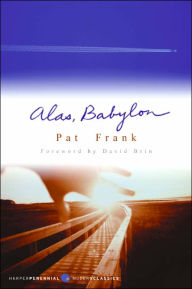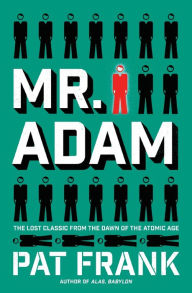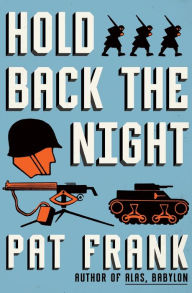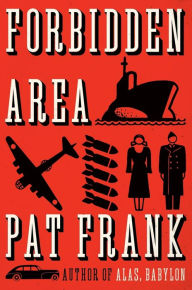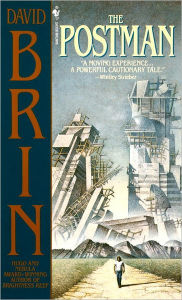Pat Frank Faced the Threat of Atomic Armageddon and Answered with Hope
 Nowadays in science fiction, we can choose how the world will end from a laundry list of grim possibilities—nanotechnology run amok, a global pandemic, the rise of the machines, runaway climate change, a zombie uprising, some or all of the above, some decidedly less likely than others.
Nowadays in science fiction, we can choose how the world will end from a laundry list of grim possibilities—nanotechnology run amok, a global pandemic, the rise of the machines, runaway climate change, a zombie uprising, some or all of the above, some decidedly less likely than others.
Alas, Babylon
Alas, Babylon
By Pat Frank
In Stock Online
Paperback
$16.49
$17.99
But back in the 1950s and early ’60s, the threat of armageddon was atomic, and the threat was very real. Real enough for school kids like me to practice duck-and-cover drills to give us something to distract us in the event of a nuclear attack. Many authors in those years speculated on how the post-apocalypse would play out. On the Beach (1957) told of the last human survivors in Australia, waiting to die as radioactive fallout drifted from the northern hemisphere. In A Canticle for Leibowitz (1960), Walter Miller imagined the world a thousand years after, creeping back toward technology, and the same mistakes. But one post-apocalyptic book from that period painted a more hopeful outcome: Alas, Babylon by Pat Frank. As provocative tweets and heightened tension with Russia have helped push the Doomsday Clock 30 seconds closer to midnight, it’s a book well worth revisiting.
Named after his father, Harry Hart Frank, Pat Frank wrote under the nickname he used his entire life. He was born in Chicago in 1908 but grew up in Florida after his father died when Pat was young. As a teen, he started writing local interest stories for the Jacksonville Journal, eventually becoming a reporter for newspapers in New York and Washington. During World War II, he was appointed assistant chief of mission of the Office of War Information (OWI). The OWI distributed information, and propaganda. After three years there, he left to become a war correspondent. All of these experiences inspired a second career: novelist.
But back in the 1950s and early ’60s, the threat of armageddon was atomic, and the threat was very real. Real enough for school kids like me to practice duck-and-cover drills to give us something to distract us in the event of a nuclear attack. Many authors in those years speculated on how the post-apocalypse would play out. On the Beach (1957) told of the last human survivors in Australia, waiting to die as radioactive fallout drifted from the northern hemisphere. In A Canticle for Leibowitz (1960), Walter Miller imagined the world a thousand years after, creeping back toward technology, and the same mistakes. But one post-apocalyptic book from that period painted a more hopeful outcome: Alas, Babylon by Pat Frank. As provocative tweets and heightened tension with Russia have helped push the Doomsday Clock 30 seconds closer to midnight, it’s a book well worth revisiting.
Named after his father, Harry Hart Frank, Pat Frank wrote under the nickname he used his entire life. He was born in Chicago in 1908 but grew up in Florida after his father died when Pat was young. As a teen, he started writing local interest stories for the Jacksonville Journal, eventually becoming a reporter for newspapers in New York and Washington. During World War II, he was appointed assistant chief of mission of the Office of War Information (OWI). The OWI distributed information, and propaganda. After three years there, he left to become a war correspondent. All of these experiences inspired a second career: novelist.
Mr. Adam: A Novel
Mr. Adam: A Novel
By Pat Frank
In Stock Online
Paperback $14.99
Frank’s first novel, Mr. Adam, was a science fiction satire about radiation from a nuclear mishap sterilizing all human males, even those in utero. Except for the titular character, of course, who becomes a wanted man in many ways. Other novels followed (and, listen up, modern readers, are currently being reissued by HarperCollins Publishers): Forbidden Area and An Affair of State, both cold war thrillers; and Hold Back the Night, a story of the Korean War. The latter book, along with his experience working for the government and as war correspondent, led to Frank’s participation in the United Nations Mission to Korea in 1952, which helped broker the Korean armistice.
As storied as Frank’s life was, and as good as his other novels are, he is best remembered for Alas, Babylon. After more than 50 years, it is still considered one of the best post-apocalyptic novels ever written. The first quarter of the book sets the stage, orienting us in both the small Florida town of Fort Repose, and in world political and military arena of the late 1950s. “Alas, Babylon” is a biblical reference to the destruction of that fabled city. Brothers Mark and Randy Braggs heard it as boys in a fire and brimstone sermon. When Mark became an Air Force colonel with access to early warnings about possible atomic attacks, the phrase becomes a secret signal he uses to warn his brother to prepare for the worst.
Frank’s first novel, Mr. Adam, was a science fiction satire about radiation from a nuclear mishap sterilizing all human males, even those in utero. Except for the titular character, of course, who becomes a wanted man in many ways. Other novels followed (and, listen up, modern readers, are currently being reissued by HarperCollins Publishers): Forbidden Area and An Affair of State, both cold war thrillers; and Hold Back the Night, a story of the Korean War. The latter book, along with his experience working for the government and as war correspondent, led to Frank’s participation in the United Nations Mission to Korea in 1952, which helped broker the Korean armistice.
As storied as Frank’s life was, and as good as his other novels are, he is best remembered for Alas, Babylon. After more than 50 years, it is still considered one of the best post-apocalyptic novels ever written. The first quarter of the book sets the stage, orienting us in both the small Florida town of Fort Repose, and in world political and military arena of the late 1950s. “Alas, Babylon” is a biblical reference to the destruction of that fabled city. Brothers Mark and Randy Braggs heard it as boys in a fire and brimstone sermon. When Mark became an Air Force colonel with access to early warnings about possible atomic attacks, the phrase becomes a secret signal he uses to warn his brother to prepare for the worst.
Hold Back the Night
Hold Back the Night
By Pat Frank
In Stock Online
Paperback $14.99
And the worst does come. But the residents of Fort Repose had a chance of survival. There is no radioactive fallout, despite numerous Florida military bases being bombed, and no nuclear winter. The town is in an agricultural area, so they can still grow food, and they have access to an aquifer and a river to provide water. Most importantly, they have a leader in Randy Braggs. When Fort Repose finally receives word from what was left of the United States, they learn the few cities that remain are beset by the plagues and shortages. They residents decide to face “the thousand year night” right there, in their community.
The book shines in Frank’s little touches. Randy Bragg considers a “whites only” water fountain, now meaningless, as there is no longer running water, and every man, and woman, is crucial to the community’s survival, regardless of race. After “The Day” when the bombs fall, the town banker tries to send a telegram to the Federal Reserve Bank in Jacksonville requesting instructions. The telegraph agent tells him, “I’m very sorry…but I can’t send this. Jacksonville doesn’t seem to be there any more.”
And the worst does come. But the residents of Fort Repose had a chance of survival. There is no radioactive fallout, despite numerous Florida military bases being bombed, and no nuclear winter. The town is in an agricultural area, so they can still grow food, and they have access to an aquifer and a river to provide water. Most importantly, they have a leader in Randy Braggs. When Fort Repose finally receives word from what was left of the United States, they learn the few cities that remain are beset by the plagues and shortages. They residents decide to face “the thousand year night” right there, in their community.
The book shines in Frank’s little touches. Randy Bragg considers a “whites only” water fountain, now meaningless, as there is no longer running water, and every man, and woman, is crucial to the community’s survival, regardless of race. After “The Day” when the bombs fall, the town banker tries to send a telegram to the Federal Reserve Bank in Jacksonville requesting instructions. The telegraph agent tells him, “I’m very sorry…but I can’t send this. Jacksonville doesn’t seem to be there any more.”
Forbidden Area
Forbidden Area
By Pat Frank
In Stock Online
Paperback $15.99
After the success of Alas, Babylon in 1959, Frank stopped writing novels. But he continued to write—articles for various magazines; a story, “The Girl Who Almost Got Away,” that become the Rock Hudson movie Man’s Favorite Sport?; and, just in time for the Cuban missile crisis in 1962, How to Survive the H Bomb and Why. (Frank’s best survival suggestion was to live in Tasmania, so he apparently did not read On the Beach.) He was also active with the Democratic National Committee, contributed to John F. Kennedy’s presidential campaign, and, in keeping with his interest in nuclear war, worked in Washington for the Civil Defense Department. He died in 1964 at the age of 57. (For some more colorful details of Pat Frank’s life, see this Florida newspaper feature, published to mark the 50th anniversary of Alas Babylon.)
After the success of Alas, Babylon in 1959, Frank stopped writing novels. But he continued to write—articles for various magazines; a story, “The Girl Who Almost Got Away,” that become the Rock Hudson movie Man’s Favorite Sport?; and, just in time for the Cuban missile crisis in 1962, How to Survive the H Bomb and Why. (Frank’s best survival suggestion was to live in Tasmania, so he apparently did not read On the Beach.) He was also active with the Democratic National Committee, contributed to John F. Kennedy’s presidential campaign, and, in keeping with his interest in nuclear war, worked in Washington for the Civil Defense Department. He died in 1964 at the age of 57. (For some more colorful details of Pat Frank’s life, see this Florida newspaper feature, published to mark the 50th anniversary of Alas Babylon.)
The Postman
The Postman
By David Brin
Paperback $7.99
Science fiction author David Brin wrote an excellent foreword for the HarperCollins edition of Alas Babylon, crediting it with partially inspiring his own post-apocalyptic novel The Postman (1985). Reading them both in close succession, the influence is clear. Their protagonists are both men forced by their ideals to lead, and to take drastic action to save others. In both, uniforms are important symbols of order in chaotic times. Both take place in areas somewhat protected from the effects of the war. And despite the harsh conditions, and the malevolence shown by bandits and survivalists, both books hold to the belief that there is hope for humanity, and civilization.
A message as important now as it has ever been.
Science fiction author David Brin wrote an excellent foreword for the HarperCollins edition of Alas Babylon, crediting it with partially inspiring his own post-apocalyptic novel The Postman (1985). Reading them both in close succession, the influence is clear. Their protagonists are both men forced by their ideals to lead, and to take drastic action to save others. In both, uniforms are important symbols of order in chaotic times. Both take place in areas somewhat protected from the effects of the war. And despite the harsh conditions, and the malevolence shown by bandits and survivalists, both books hold to the belief that there is hope for humanity, and civilization.
A message as important now as it has ever been.
